Recent Posts
Enjoy the BBQs, fireworks & fun, but be safe
6/13/2024 (Permalink)
 Grilling is a major part of backyard gatherings in Summer. Follow these safety tips to avoid a fire.
Grilling is a major part of backyard gatherings in Summer. Follow these safety tips to avoid a fire.
Summer is just over a week away and is traditionally known for barbeques, picnics and of course, July Fourth fireworks!
While putting on a firework show at your own home may seem fun, there are many risks. If lighting fireworks is not legal in your residential area there could be a large fine. Moreover, keep in mind the potential dangers that could occur as a result of fireworks, such as severe burns, blindness and scars.
Kids should not be near or handling the firecrackers or rockets. Supervise children around fireworks at all times. To avoid the dangers of fireworks, enjoy a public fireworks display conducted by professionals.
If you choose to give your children sparklers, never leave children unattended with these. It is possible to get burned by the tip of the sparkler. Make sure your children do not point the sparklers towards themselves or others. Keep a bucket of water nearby for when your child is finished with the sparkler to ensure that the sparkler is no longer lit.
Take precaution for your pets, too! Leave your pets inside your home so there are no risks. Loud fireworks and unfamiliar places can be scary to pets.
And of course summer isn't summer without outdoor grills! Remember these tips when grilling:
- Never grill in an enclosed area, as carbon monoxide could be produced.
- Use caution when using lighter fluid on a barbeque. Do not add fluid to an already-lit fire, as the flame can flash back into the container and explode.
- Make sure children are away from the grill.
Have fun this summer and stay safe!
Know who to call in the event you have fire or water damage in your home or business. Our emergency response teams at SERVPRO of Laurel & SERVPRO of Greenbelt NE/Beltsville E are here 24/7 to help! 301-323-8862.
Tips for returning to a flood-damaged home
5/28/2024 (Permalink)
 Beware that your house may be contaminated when returning home after a flood or other natural disasters.
Beware that your house may be contaminated when returning home after a flood or other natural disasters.
Water – one of life’s essentials, for without it, we simply cannot survive.
But flood and contaminated water – water from natural disasters, and from contaminated sources like sewage and overflowed toilets & such – are toxic and can cause numerous health hazards and diseases that can be fatal, if exposed.
With Spring in full swing and the Summer months just ahead, families will be vacationing and traveling away from home. Suppose there was a big storm with heavy flooding while you were away, and your home was flooded and you’ve returned to face standing water throughout the home.
It’s many homeowners’ worst nightmare. What to do?
For starters, the Centers for Disease and Control advises that, if possible, try to return home during the daytime so that you do not have to use any lights. Use battery-powered flashlights and lanterns, rather than candles, gas lanterns, or torches.
The agency also offers the following:
- If you have standing water in your home and can turn off the main power from a dry location, then go ahead and turn off the power, even if it delays cleaning. If you must enter standing water to access the main power switch, then call an electrician to turn it off. NEVER turn power on or off yourself or use an electric tool or appliance while standing in water.
- Have an electrician check the house’s electrical system before turning the power on again.
- If you smell gas or suspect a leak, turn off the main gas valve, open all windows, and leave your house immediately. Notify the gas company or the police or fire departments or State Fire Marshal’s office, and do not turn on the lights or do anything that could cause a spark. Do not return until you are told it is safe to do so.
- If the house has been closed up for several days, enter briefly to open doors and windows to let the house air out for a while (at least 30 minutes) before you stay for any length of time.
- If your home has been flooded and has been closed up for several days, assume your home has mold.
- If your home has been flooded, it also may be contaminated with sewage. Call a professional home inspector to check for contamination. If confirmed, have a licensed company remove & remediate mold and sewage. Our certified crews from SERVPRO of Laurel & SERVPRO of Greenbelt NE/Beltsville E are especially trained for such work, and are available 24/7 to help!
FOOD. The next step is to go through your home to discard perishable items and anything that has been contaminated with standing water. On top of that list is food; throw away food that may have come in contact with flood or storm water; perishable foods that have not been refrigerated properly due to power outages; and those with an unusual odor, color, or texture. Unsafe food can make you sick even if it looks, smells and tastes normal. When in doubt, throw it out!
WATER. Food water can contaminate drinking water from your home’s faucets. Until the water is tested, use bottled or water that has been properly boiled to kill any contaminants.
Some contaminants from surface water can get into the groundwater and affect private drinking water wells and municipal water systems that use groundwater. The CDC suggests the following steps:
- Follow local guidance on whether your water is safe to drink.
- If you have a private well and live in an area with flooding, get your water tested before you use it.
- Do not use water you suspect or have been told is contaminated to wash dishes, brush your teeth, wash and prepare food, wash your hands, make ice, or make baby formula. Safe water for drinking, cooking and personal hygiene includes bottled, boiled, or treated water.
- Your state, local, or tribal health department can make specific recommendations for boiling or treating water in your area.
Until your power is restored after dryout, use generators and other electrical sources and equipment safely. Talk to your utility company about using electrical equipment, including power generators. Be aware that it is against the law and a violation of electrical codes to connect generators to your home’s electrical circuits without the approved, automatic-interrupt devices. If a generator is on line when electrical service is restored, it can become a major fire hazard. In addition, the improper connection of a generator to your home’s electrical circuits may endanger line workers helping to restore power in your area.
- All electrical equipment and appliances must be completely dry before returning them to service. Have a certified electrician check these items if there is any question.
- Never use a generator, pressure washer, or any gasoline-powered engine inside your home, basement, or garage or less than 20 feet from any window, door, or vent.
The next step is to prevent MOLD from the flood or storm water, by drying out your home. Follow these steps from the CDC:
- If you have electricity and an electrician has determined that it’s safe to turn it on, use a “wet-dry” shop vacuum (or the vacuum function of a carpet steam cleaner), an electric-powered water transfer pump, or sump pump to remove standing water. If you are operating equipment in wet areas, be sure to wear rubber boots.
- If you do not have electricity, or it is not safe to turn it on, you can use a portable generator to power equipment to remove standing water. Note: If you must use a gasoline-powered pump, generator, pressure washer, or any other gasoline-powered tools to clean your home, never operate the gasoline engine inside a home, basement, garage, carport, porch, or other enclosed or partially enclosed structures, or less than 20 feet from any door, window, or vent, even if the windows and doors are open. Such improper use can create dangerously high levels of carbon monoxide and cause carbon monoxide poisoning.
- If weather permits, open windows and doors of the house to aid in the drying-out process.
- Use fans and dehumidifiers to remove excess moisture. Fans should be placed at a window or door to blow the air outwards rather than inwards, so not to spread the mold.
- Have your home heating, ventilating, and air-conditioning (HVAC) system checked and cleaned by a maintenance or service professional who is experienced in mold cleanup before you turn it on. If the HVAC system was flooded with water, turning on the mold-contaminated HVAC will spread mold throughout the house. Professional cleaning will kill the mold and prevent later mold growth. When the service determines that your system is clean and if it is safe to do so, you can turn it on and use it to help remove excess moisture from your home.
- Prevent water outdoors from reentering your home. For example, rainwater from gutters or the roof should drain away from the house; the ground around the house should slope away from the house to keep basements and crawl spaces dry.
- Ensure that crawl spaces in basements have proper drainage to limit water seepage. Ventilate to allow the area to dry out.
The CDC and the American Red Cross offer great resources for storm and fire prevention and response. Visit their webpages for more information:
www.cdc.gov/floods/about/?CDC_AAref_Val=https://www.cdc.gov/disasters/floods
www.redcross.org/get-help/how-to-prepare-for-emergencies/types-of-emergencies/flood
Finally, when you are ready for that monstrous task of cleanup and remediation, you can rely on SERVPRO of Laurel and SERVPRO of Greenbelt NE/Beltsville E. We are the area’s water & storm damage experts, as well as mold remediation and restoration. Large or small, we will restore your water-damaged property, residential or commercial, with efficiency and detail.
Call us 24/7 at 301-323-8862 or 301-340-1313.
Tips on how to recover flood-damaged items
5/28/2024 (Permalink)
 Follow these tips to help dry out your flood-damaged items quickly.
Follow these tips to help dry out your flood-damaged items quickly.
If you’ve ever experienced a house flood, you might have lost a few items, or maybe you lost most of your possessions depending on the extent of the waters and how long you waited to dry your furnishings, accessories and trinkets.
If you want to salvage your goods after experiencing a flooding, it’s essential to dry items within a 48-hour time frame.
We offer some tips to help save your items:
- Improve air circulation! Don’t contain the moisture. Instead, open windows and doors. If there are no windows or doors leading outside in the particular room, open closet and cabinet doors.
- Turn on a fan! It can either be a ceiling fan, a floor fan, or both. However, please do not plug a fan into an outlet attached to a wall that is wet or has water behind it. That’s an easy way to get electrocuted.
- Use a dehumidifier. These remove water vapor from the air. To be effective, it must be used in a contained area. Be sure to shut all doors and windows during use to prohibit more humidity from entering.
- Use a sump pump. These remove water out of house or office through a hose or pipe. They’re useful when the floodwater level is more than a couple inches deep.
- Got soaked items? Quickly take them out of your house and allow them to dry off in the sun. Keeping them indoors will ensure nothing ever dries up as their excessive moisture will travel to surrounding objects.
- Try a wet-dry shop vacuum. Never use a regular vacuum cleaner. A shop vac is specifically made for wet conditions.
At SERVPRO of Laurel and SERVPRO of Greenbelt NE/Beltsville E, we are water damage cleanup & restoration experts. With well-trained technicians and the latest state-of-the-art equipment, you can trust us to clean up and restore your property "Like it never even happened."
Give SERVPRO Team Gutierrez of Laurel, Greenbelt & Beltsville a call today at 301-323-8862 if you have any questions or need water damage restoration. We are open 24/7 and here to help!
Be Prepared for Those Unpredictable Spring & Summer Storms
5/3/2024 (Permalink)
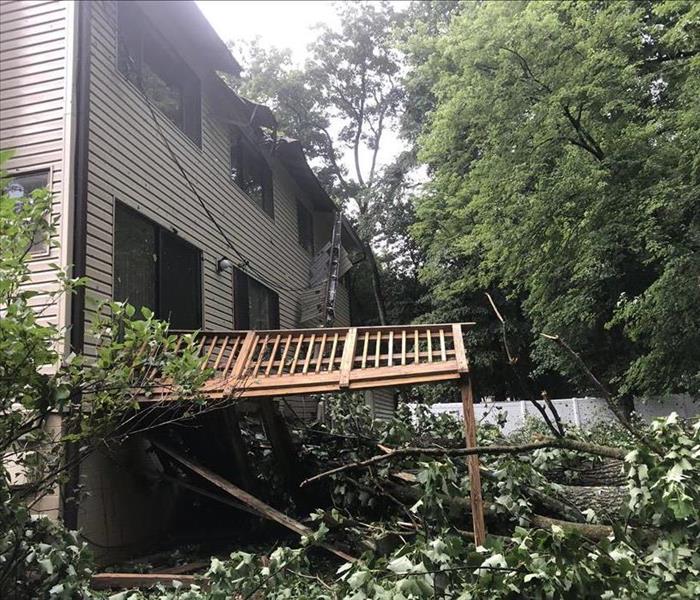 Spring & Summer storms can occur anytime. Be prepared!
Spring & Summer storms can occur anytime. Be prepared!
SERVPRO® of Laurel and SERVPRO of Greenbelt NE/Beltsville E want you to be ready for summer storms. While we hope that summer just consists of vacations and sunny days, that is not always the case.
Spring or summer storms happen quite often in Maryland including Prince George's County. There are many possibilities of damage from storms, whether from wind, heavy rain, or lightning. Wind can cause structural damage to your home, heavy rain can lead to flooding and if lightning strikes on your property, it is at risk of a fire.
If you know a storm is coming, take these initiatives to ensure safety:
- Secure outdoor objects that could blow away or cause damage.
- Shutter windows and secure outside doors.
- Unplug any electronic equipment.
During the storm, remain calm and be aware.
- Use your battery-operated NOAA Weather Radio for updates from local officials.
- Avoid contact with cords.
- Stay away from windows and doors.
After the Storm, BE SAFE! It may not be storming anymore but the damage can still affect you.
- Never drive through a flooded roadway.
- Stay away from storm-damaged areas to keep from putting yourself at risk.
- Stay away from downed power lines and report them immediately to 911.
If you're caught off-guard to a dangerous storm that causes property damage, don’t stress, we have Emergency Response Teams 24/7 who are specially-trained to deal with the mess of a storm. Let us be the experts you need in your time of crisis. Give SERVPRO Team Gutierrez a call at 301-323-8862.
Do your health a favor by keeping your duct system clean!
5/3/2024 (Permalink)
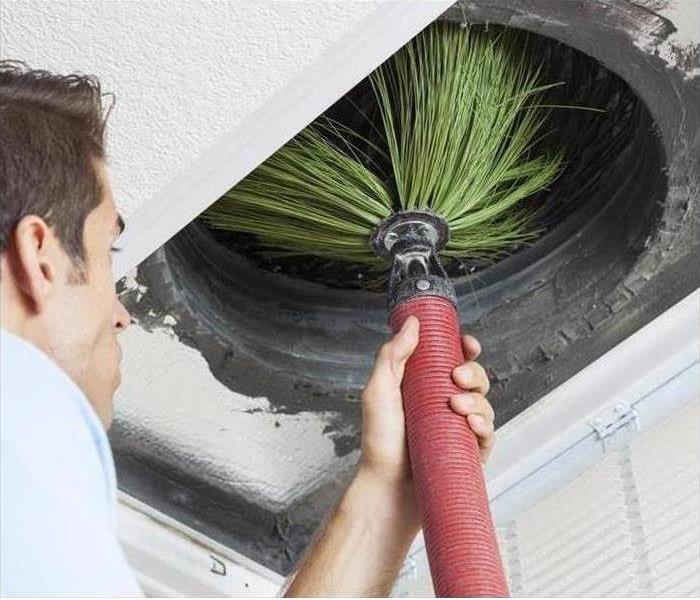 Keeping your duct system clean not only keeps a healthy home, but saves money!
Keeping your duct system clean not only keeps a healthy home, but saves money!
Dust, pet dander & other containments from everyday living are circulated through your ducts and can decrease the efficiency of your HVAC heating and cooling system, causing it to work much harder.
Keeping the ductwork clean can extend the life span of the equipment by allowing it to operate at peak condition, which saves money.
Duct Cleaning can:
- Remediate Bacteria, Fungi and Mold
- Reduce Potential for Mold Growth
- Restore Peak Energy Efficiency
- Eliminate Offensive Odors
Since the ventilation system is often the biggest culprit in poor indoor air quality, keeping your ductwork clean should be a high priority. In most cases, the HVAC system has been operating for some time without much attention. Dirty ducts can circulate odors, contaminants such as mold and irritating dust throughout your building or home.
These contaminants from day to day living are sucked into your HVAC system and recirculated throughout your home over and over. This causes a buildup over time inside the ductwork.
“In the last several years, a growing body of scientific evidence has indicated that the air within homes and other buildings can be more seriously polluted than the outdoor air in even the largest and most industrialized cities," according to the EPA website.
Cleaning your ducts can sweep away years of dust and dirt, helping to keep our allergies at bay.
In some circumstances, such as after a fire, smoke or suspected mold growth, duct cleaning becomes an essential part of the cleanup process. This includes certain odors as well. In these cases, a SERVPRO® Duct Cleaning Professional can often restore the ductwork to pre-damage condition. It is also recommended that you have the ductwork cleaned after buying a home or after a renovation. Just like carpet cleaning, having your ductwork cleaned should be part of your home maintenance routine.
Call SERVPRO of Laurel & Greenbelt NE/Beltsville E today to schedule your duct cleaning! 301-323-8862.
Now is the time to prepare for a ‘turbulent’ 2024 Hurricane Season!
5/3/2024 (Permalink)
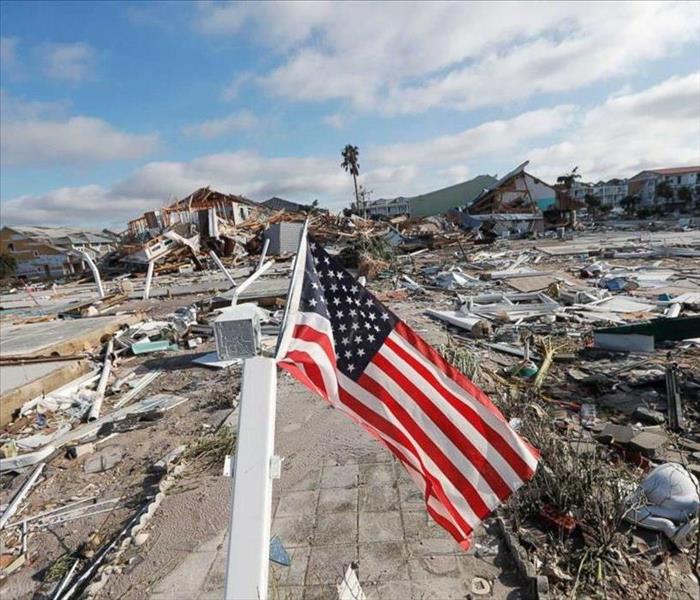 Weather forecasters are predicting a turbulent 2024 hurricane season. Prepare your family & property to stay safe and for quick response!
Weather forecasters are predicting a turbulent 2024 hurricane season. Prepare your family & property to stay safe and for quick response!
Meteorologists are predicting 2024 to be one of the most turbulent hurricane seasons on record, with 24 named storms and 11 hurricanes forecasted. Six of those hurricanes are predicted to reach Category 3 status or stronger.
“The 2024 Atlantic hurricane season is forecast to feature well above the historical average number of tropical storms, hurricanes, major hurricanes and direct U.S. impacts," AccuWeather Lead Hurricane Forecaster Alex DaSilva said in an accuweather.com article.
Jonathan Belles, a graphics meteorologist and writer for weather.com, wrote that bigger impact from the hurricanes is likely this year. “Forecasters are also worried about more landfalls this season due to a troubling setup for storm movement,” he wrote.
Unlike last season, “a stronger high-pressure system is expected to set up shop near Bermuda and the Azores, which should deflect more storms westward toward the Caribbean and the United States,” Belles wrote.
As a restoration company – SERVPRO® Team Gutierrez of Laurel & Greenbelt NE/Beltsville E, as well as our flagship franchises in Montgomery County, SERVPRO of Rockville-Olney & Silver Spring North – is always prepared for disasters, and especially Hurricane Season that begins June 1 and ends November 30.
Now is a good time to prepare your family and your property to help keep you safe & minimize response time. The American Red Cross offers these Hurricane Safety tips:
Plan to Evacuate
- If advised to evacuate, do so immediately and go to a safe place.
- Know where you will go, how you will get there, and where you will stay.
- Plan well in advance if you will need help leaving or use public transportation.
- Mobile & trailer homes and recreational vehicles (RVs) cannot provide safe shelter from tropical-storm or hurricane-force winds.
Plan to Shelter Safely
- Be ready to live without power, water, gas, phone, and internet for a long time.
- Practice going to a designated safe shelter for high winds. The next best protection is a small, interior, windowless room in a sturdy building on the lowest level that is not likely to flood.
- If you are in an area that is likely to flood, designate a location on higher ground that you can move to before floodwaters reach you.
Storm & water damage in your property can cause further damage if not mitigated swiftly and properly. That’s why our SERVPRO emergency response teams are on call 24/7 to help.
We have trained & experienced manpower, state-of-the-art equipment, and tried-and-true method to restore your property to preloss condition, “Like it never even happened.” Give us a call and see why our SERVPRO brand has been consistently ranked #1 by Entrepreneur magazine in the restoration services category for 22 years. 301-323-8862.
Let's keep our school campuses mold-free!
4/12/2024 (Permalink)
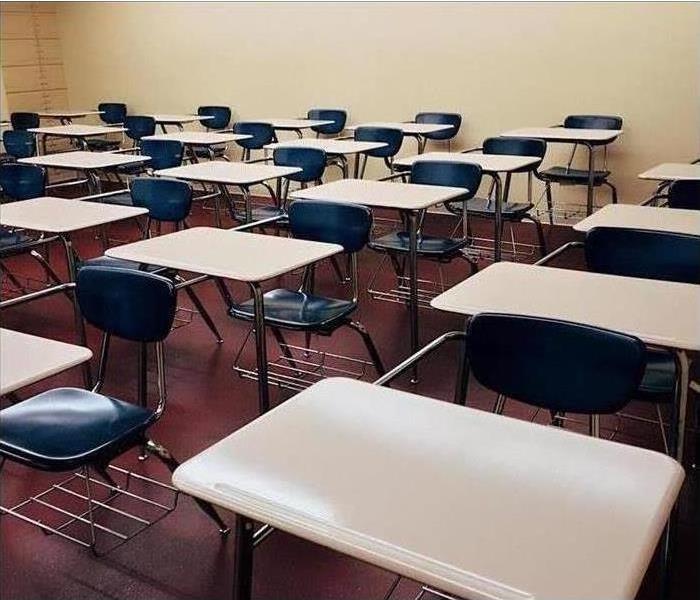 To keep our students safe, we must ensure their campus is mold-free!
To keep our students safe, we must ensure their campus is mold-free!
Schools that have experienced water damage from incidents such as plumbing leaks, water overflows from toilets, or poor drainage of rainwater, are at risk of mold growth, which can take place within the first 48 hours of the accident.
If you can see its visible growth or can smell it (usually similar to that of something rotting), it’s an obvious indicator. After water damage, you can expect mold and in a school especially, it’s imperative to call professionals to come take a look as students’ and faculties’ health alike are at risk.
Yet there are other instances where mold isn’t caused immediately by a plumping issue, for example. Mold can grow behind paint, walls, under tiles, etc. and can grow there for years. Mold can be growing behind paint and begin appearing over it, but simply scrubbing the mold off the paint won’t solve the problem as only part of the problem was removed, and it will just grow back.
In these cases, remediation is necessary. Give SERVPRO of Laurel/Greenbelt-Beltsville a call today at (301) 323-8862.
We serve public and private schools throughout the Maryland, Virginia & DC region. Mold can pose serious health risks including fatigue, nausea, headaches and respiratory irritation, to name a few.
Our technicians are well-trained and seasoned in mold remediation and will have your classrooms and other school facilities mold-free and safe in no time!
Got MOLD? Leave it to your friends at SERVPRO Laurel & Greenbelt!
4/11/2024 (Permalink)
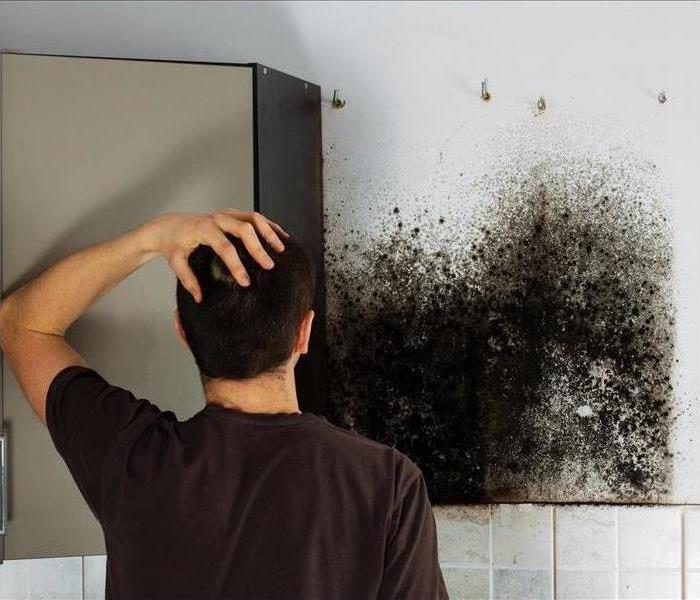 Mold exposure can be hazardous to our health. Leave it to our certified technicians for safe cleanup & mitigation.
Mold exposure can be hazardous to our health. Leave it to our certified technicians for safe cleanup & mitigation.
We’ve all heard of black mold, but what exactly is it? And if your business or company headquarters have sightly signs of mold, they may discourage your customers and visitors.
One of the most obvious signs happens to be scent. Have you smelled something earthy or musty? Think of a late fall’s odor of rotting leaves or the smell of dirt on a rainy spring day.
Next, consider the environment in which you suspect the mold is inhabiting, and ask yourself the following questions:
- Is the area damp?
- Has the area previously been flooded?
- Does it get little to no exposure to light?
Black mold feeds off water-saturated materials such as cotton, drywall, cardboard and wood. It even thrives off of damp dust and lint.
If the scent of the mold leads you straight to where it is festering, examine the color but don’t get too close. In color, black mold is typically greenish-black and a bit slimy. However, it can also appear grayish and powdery.
Note other molds may appear similar in color, so it is impossible to determine which breed of mold is growing in your property unless it is examined under a microscope.
At the end of the day, this examination is expensive and unnecessary because whether it is black mold or not, mold must be removed for health and sanitary purposes.
If you detect mold, regardless of its color or texture, call the professionals to have it removed.
SERVPRO® of Laurel and SERVPRO of Greenbelt NE/Beltsville E are the area’s water & storm damage, and mold & mildew remediation experts. Large or small, we will restore your mold- and water-damaged property, residential or commercial, with efficiency and detail.
Call us 24/7 at 301-323-8862 or 301-615-4884.
Spring is nice, but be prepared for those unexpected storms!
4/11/2024 (Permalink)
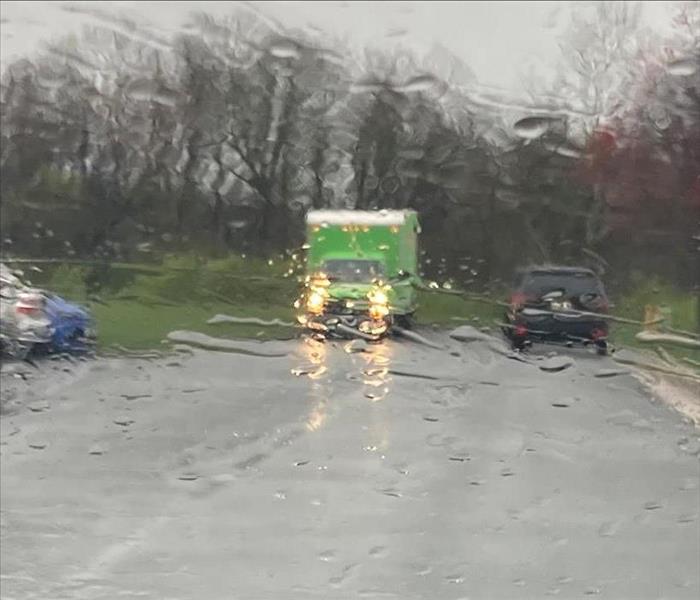 Get the home and yard ready for those unexpected storms!
Get the home and yard ready for those unexpected storms!
Ahhh! Spring… Balmy weather one day; frigid to near-freeze temperature overnight. To wear a sweater or not. To bring in the plants or not…
Spring weather can be unpredictable, as many of us here in the Washington, D.C. region have experienced a time or two. Remember the heavy April snowfall over a decade ago? And the wind gusts of 20-30+ mph every now and then, like the one our DMV experienced just over the weekend in late March.
While we can’t predict when severe weather hits, we can always plan for those unexpected storms to minimize injury to ourselves and damages to our properties. A viable plan of action for storms, floods, tornadoes, even fires, can save lives and costly repairs in the aftermath of severe weather that can occur, even within the same day.
Mark Twain said it best: “In the spring I have counted one hundred and thirty-six kinds of weather inside of four and twenty hours.”
Preparing an emergency kit to keep on hand is a great start to advance planning for storms. Some items to include, as suggested by the Centers for Disease Control and Prevention, are:
- A battery-operated flashlight, a battery-operated NOAA Weather Radio, and extra batteries for both
- An emergency evacuation or shelter plan, including a map of your home and routes to safety from each room
- A list of important personal information, including:
- telephone numbers of neighbors, family and friends
- insurance and property information
- telephone numbers of utility companies
- medical information
- A 3–5 day supply of bottled water and nonperishable food
- Personal hygiene items
- Blankets or sleeping bags
- A first-aid kit, which may include:
- non-latex gloves
- assortment of adhesive bandages
- antibiotic ointment
- sterile gauze pads in assorted sizes
- absorbent compress dressings
- tweezers
- scissors
- adhesive cloth tape
- aspirin packets
Being prepared & proactive for storms and severe weather can save lives and minimize costly repairs to damaged property. Oftentimes we have little if any time to prepare for an approaching storm. For families with young children, a mock emergency drill may be a fun yet helpful activity. Show them where to go; where emergency supplies are stored; and make sure everyone in the family knows where & how to turn off the water, gas and electricity in your home.
Preparedness and swift response may save a life or two!
When all’s settled and you find your damaged properties needing cleanup & restoration, call us – SERVPRO® of Laurel and SERVPRO of Greenbelt NE/Beltsville E – 24/7 at 301-323-8862 or 301-615-4884.
We are the area’s water & storm damage experts and are always “Faster to any size disaster.” Large or small, we will restore your water-damaged property, residential or commercial, with efficiency and detail.
Let SERVPRO Laurel/Greenbelt take your facilities to the next level of Clean!
4/9/2024 (Permalink)
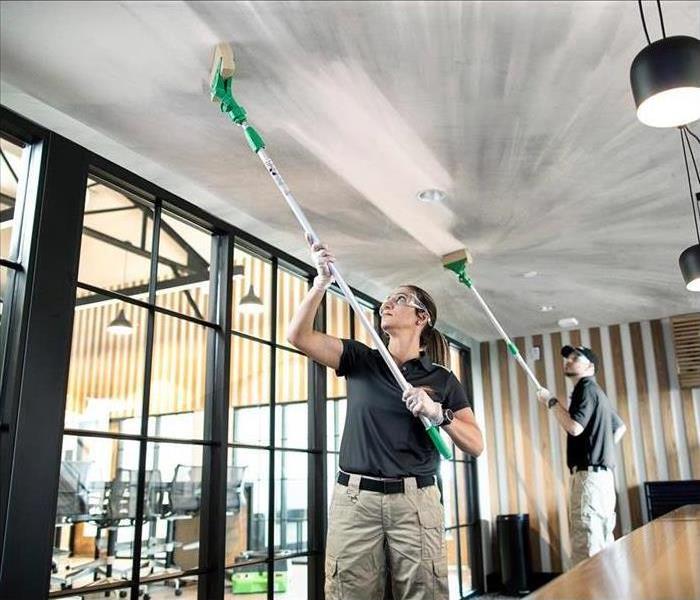 It's always important to keep commercial facilities such as businesses, hospitals & schools clean to protect everyone's health.
It's always important to keep commercial facilities such as businesses, hospitals & schools clean to protect everyone's health.
What the recent pandemic has taught the world is that clean and disinfected spaces, especially in public, continues to be key to keeping everyone safe and healthy.
With the country back to nearly 100 percent normal and most businesses and workplaces operating in person as usual, we want to remind our clients that it's still important to have buildings and facilities thoroughly cleaned to keep everyone safe from germs and other health hazards.
While the COVID-19 pandemic has changed what it means to be clean, SERVPRO® franchises throughout the country – including SERVPRO® of Laurel & Greenbelt NE/Beltsville E and SERVPRO® of Rockville-Olney & Silver Spring North – are here to help keep your customers and employees safe with our commercial cleaning services.
We use a proactive viral pathogen cleaning program backed by our more than 50 years of experience in cleanup and restoration.
Our commercial clients include daycares, schools, government entities such as police & fire stations, hospitals, and condo & apartment buildings.
Give us a call today at 301-323-8862 and let our crews take your facilities to the next level of CLEAN!
 Grilling is a major part of backyard gatherings in Summer. Follow these safety tips to avoid a fire.
Grilling is a major part of backyard gatherings in Summer. Follow these safety tips to avoid a fire.





 24/7 Emergency Service
24/7 Emergency Service








